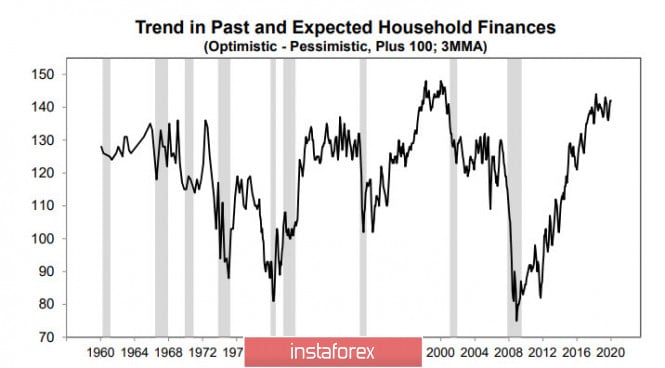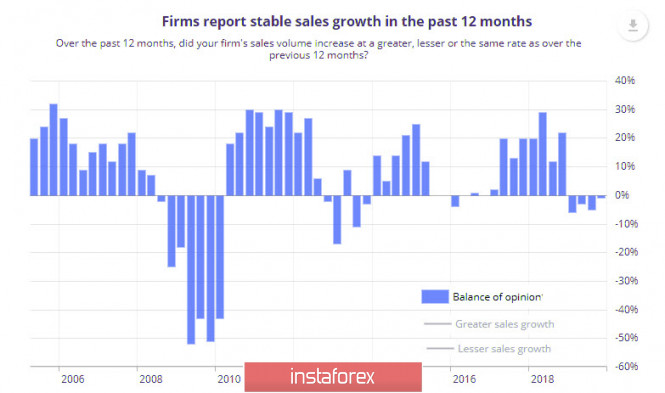The stock indices of the Asia-Pacific countries started the week with growth, continuing the tendency to lower anti-risk sentiment that took shape last week after signing the first phase of the US-China trade deal. As of 6:00 Universal time, the Shanghai Composite is adding 0.47%, Nikkei 225 is growing by 0.23%, and demand in oil has recovered - Brent is adding 1.30%.
At the same time, the dollar looks unconvincing. There is no growth against the Japanese yen amid a decrease in risks, gold has updated a 12-day high, increasing above 1560 again. The explanation is logical - reducing trading risks reduces the demand for defensive assets, but at the same time, internal factors increase dollar does not contribute.
Consumer sentiment in January worsened from 99.3p to 99.1p according to the University of Michigan, and they can't return to the level of reached highs for a year now.

Despite all efforts, industrial production continues to decline - in December, a 0.3% reduction was recorded again, while capacity utilization was kept near two-year lows.
A reduction in the supply in the repo market by the Fed could lead to a strengthening dollar, but the liquidity flow will not decrease, but on the contrary, it may even grow, since there will be a tax return period that will seriously increase the supply in February.
Meanwhile, the net long dollar position declined from 40.8 thousand to 33 thousand over the week, due to a combination of factors according to the CFTC. Therefore, the dollar is likely to decline against G10 in the short term.
The coming week will be quite informative. A number of central banks will hold meetings on monetary policy. On Monday, the National Bank of China will decide on a new discount rate, which is projected to remain unchanged. At the same time, the Bank of Japan will take the baton on Tuesday. No changes in the rate are also expected, but forecasts are likely to be revised, as the government is faced with the need to significantly increase costs. On Wednesday, the Bank of Canada will meet and the head of BoC Poloz will deliver a speech. The meeting will be held by the ECB on Thursday, and the launch of a review of the monetary strategy will be formalized.
USD/CAD
The Bank of Canada continues to adhere to a cautiously positive assessment of the Canadian economy. In the quarterly review of business prospects, it is noted that business sentiment remains generally positive, and expectations of an increase in both domestic demand and exports are growing. In the positive territory, there are also expectations for investment growth, inflationary pressures do not change, business expectations are generally stable, but there has been no steady sales growth for 12 months now, and these statistics make the whole positive design from BoC quite unsteady.

The Canadian currency turned out to be little defenseless against the news about the trade deal. Trading was in the expected range and perhaps, the players are not in a hurry to change their long-term strategies before announcing the results of the meeting of the Bank of Canada. On Wednesday, Stephen Poloz has already warned that hasty steps should not be expected. Poloz will leave his post on June 2 and the the markets expect another rate cut until this time, but, apparently, not next Wednesday.
However, there will be many reasons for the growth of volatility this week even taking into account the possibly neutral outcome of the BoC meeting. Manufacturing sales report on Tuesday, wholesale, consumer inflation and housing sales index on Wednesday, and retail sales on Friday.
The decline of the dollar last week is similar to a weak bullish reversal with a base of 1.2950, but the inability of the USD/CAD to move higher gives reason for the resumption of sales. Before Wednesday, leaving the range 1.3025 / 90 is unlikely and according to the results of the week, switching to the range 1.2950 / 3030 looks preferable.
USD/JPY
Japan's economy continues to slide into a "soft recession," which is clearly manifested in declining exports and a downward turn in industry. Industrial production in November declined by 1%, while the annual decline is 8.2%, that is, in the region of 7-year lows, which means that the Abe program launched in April 2014 on large-scale stimulation essentially has a negative result.
As a result, the weakness of the dollar holds back the growth of USD/JPY, but updating the maximum of 110.28 is very likely. The target is 110.96 and support is 109.65 / 75. Positive market sentiment will push the pair up.
The material has been provided by InstaForex Company - www.instaforex.com